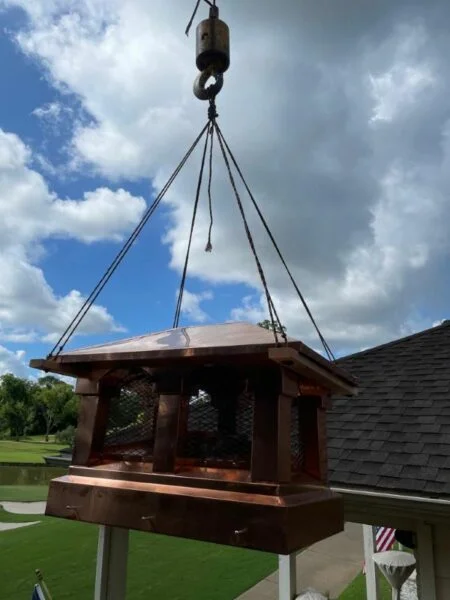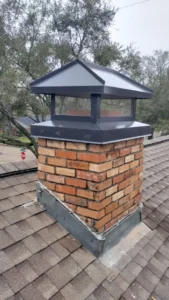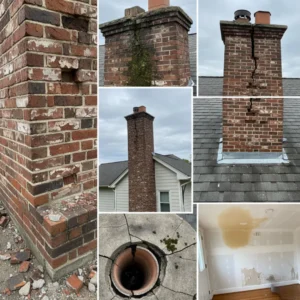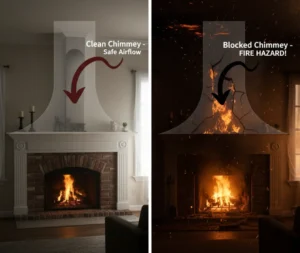Your chimney cap may seem like a small detail, but it plays a huge role in protecting your home. A chimney cap sits at the very top of your chimney and works as a shield against rain, debris, and even animals. In Houston, where the weather often brings heavy rain, humidity, and sudden storms, chimney caps are essential for keeping your fireplace system safe and efficient. For a full overview of what we handle, explore our chimney services.
But what happens when your chimney cap is damaged? Homeowners often wonder if they should repair it or replace it entirely. Understanding the difference helps you make the best choice for your Houston home. In many cases, the first step is a professional chimney inspection.
What Does a Chimney Cap Do? 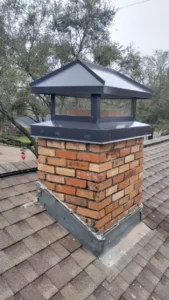
Before diving into repair vs. replacement, it’s important to know why chimney caps matter. A chimney cap is usually made of stainless steel, copper, or galvanized metal. Some even have mesh sides for extra protection. Its main jobs are simple but critical:
- Keeping rainwater out of the chimney
- Blocking leaves, sticks, and debris
- Preventing birds, squirrels, and other animals from nesting inside
- Reducing downdrafts, which can push smoke back into your home
- Protecting against sparks that could escape and cause roof fires
Without a working cap, your chimney is exposed to water damage, blockages, and even pests. Over time, these issues can lead to costly repairs. When you’re ready to fix or upgrade, book expert chimney cap repair and installation.
Common Chimney Cap Problems in Houston
Houston’s humid climate puts chimney caps through a lot. Frequent rainstorms, high humidity, and salty air near the coast can cause rust and corrosion. Strong winds may bend or loosen caps. In some cases, animals chew or damage the mesh around the cap. Other times, caps shift out of place due to normal wear and tear. Once damaged, the cap can no longer provide full protection, leaving your chimney vulnerable to leaky chimney issues and structural concerns.
Other times, caps shift out of place due to normal wear and tear. Once damaged, the cap can no longer provide full protection, leaving your chimney vulnerable. That’s when you must decide between repairing or replacing it.
When to Repair a Chimney Cap
Not all chimney cap problems require replacement. In some cases, simple repairs are enough.
If the cap is slightly loose, it can often be re secured with proper fasteners. Small areas of rust may be sanded down and treated with protective coatings. If the mesh screen is damaged but the frame is still solid, replacing only the mesh is usually possible.
Repairs are best for minor issues where the main structure of the cap is still strong. A certified tech can also verify that adjacent parts like chimney flashing aren’t the hidden source of leaks.
When Replacement Is the Better Choice
Sometimes, repairing a cap is not enough. If the metal is heavily rusted, bent, or cracked, replacement is the best option. A weakened cap won’t withstand Houston’s heavy rains or strong winds.
Another time replacement makes sense is when the cap is very old. Over time, even good repairs won’t stop continued wear. Installing a new cap ensures your chimney is fully protected for years to come. If storm damage bent the metal beyond saving, ask about proper chimney flashing replacement at the same visit to seal the system tight.
Homeowners may also choose replacement if they want to upgrade. New caps often come with improved designs, better rust resistance, and tighter mesh to keep out smaller animals.
Cost of Chimney Cap Repair vs. Replacement in Houston
Cost is often a deciding factor. In general, chimney cap repairs are less expensive than replacements. Small repairs might cost less and help you squeeze a few more years out of the cap.
Replacement usually costs more upfront, but it can save money in the long run by preventing major water damage or pest problems. If water intrusion has already affected brick and joints, timely chimney masonry repair can limit the total spend.
The Risks of Delaying Repairs or Replacement
Some homeowners put off fixing a damaged chimney cap, thinking it’s not urgent. Unfortunately, delays can lead to serious problems. Rainwater entering through an unprotected top can damage the flue, cause mold growth, and weaken the fireplace structure. Persistent moisture may even require liner work such as chimney relining.
Animals nesting inside a chimney create fire hazards and block airflow. Debris build up can lead to smoke backing up into the home. All of these issues cost much more to fix than a timely cap repair or replacement.
Professional vs. DIY: Which Is Better?
Some homeowners think about repairing or replacing a chimney cap on their own. While minor tasks may seem manageable, working on a roof carries safety risks. Chimney professionals in Houston have the tools and training to handle the job safely and to size the cap correctly. If storm damage was significant, a deeper check like a Level 2 chimney inspection can catch hidden issues before they grow.
They also know how to properly size and install chimney caps. A poorly fitted cap won’t protect your chimney, even if it looks fine from the ground. For long-term peace of mind, professional installation is usually the smarter choice.
Choosing the Right Chimney Cap for Houston Homes
If you do replace your chimney cap, material choice matters. Stainless steel is one of the best options for Houston’s humid weather. It resists rust and lasts for many years. Copper caps are also durable and add a decorative touch, though they cost more. Galvanized steel is cheaper but tends to rust faster in Houston’s climate.
Mesh size also matters. Smaller mesh prevents even tiny animals and insects from entering. If wind issues persist after replacement, a quick certified chimney inspection can confirm draft and sizing are correct.
Preventive Maintenance for Longer Life
Whether you repair or replace your chimney cap, regular maintenance keeps it working longer. Schedule annual checks—your baseline should be a Level 1 chimney inspection—to spot corrosion or shifting. After major Houston storms, visually confirm the cap hasn’t bent or loosened. If widespread damage is discovered, larger structural work may fall under chimney construction.
Simple steps like these prevent small issues from becoming big repairs. A well-maintained cap can protect your home for decades.
Conclusion: Repair or Replace—What’s Best for You?
For Houston homeowners, deciding between chimney cap repair vs. replacement comes down to the condition of the cap. Small issues like loose fittings or damaged mesh can often be repaired. But if the cap is rusted, cracked, or very old, replacement is the safer and more cost effective choice.
With Houston’s frequent rain and humidity, keeping your chimney cap in top condition is essential. By acting quickly and choosing the right solution, you prevent costly damage and ensure your fireplace system works safely for years.
Protect Your Home: Is Your Chimney Cap Damaged?
The chimney cap is your home’s first line of defense against rain, pests, and debris. In Houston’s unpredictable weather, a damaged chimney cap can lead to serious and costly problems, from water damage to animal infestations. Knowing whether to repair or replace it can save you money and protect your family’s safety.
- Repair: Minor issues like a slightly bent mesh or loose screws can often be fixed quickly by a pro, saving the cost of a full replacement.
- Replacement: If your cap is severely rusted, the wrong size, or the crown is cracked, a new cap is the safest solution.
Don’t gamble with safety. Start with a thorough evaluation and get an honest plan—whether simple fixes or more involved work such as targeted chimney repair or, in rare cases, broader chimney replacement. If storm leaks were part of the problem, we also handle precise chimney installation for new components and can check related home systems during scheduled dryer vent cleaning.

